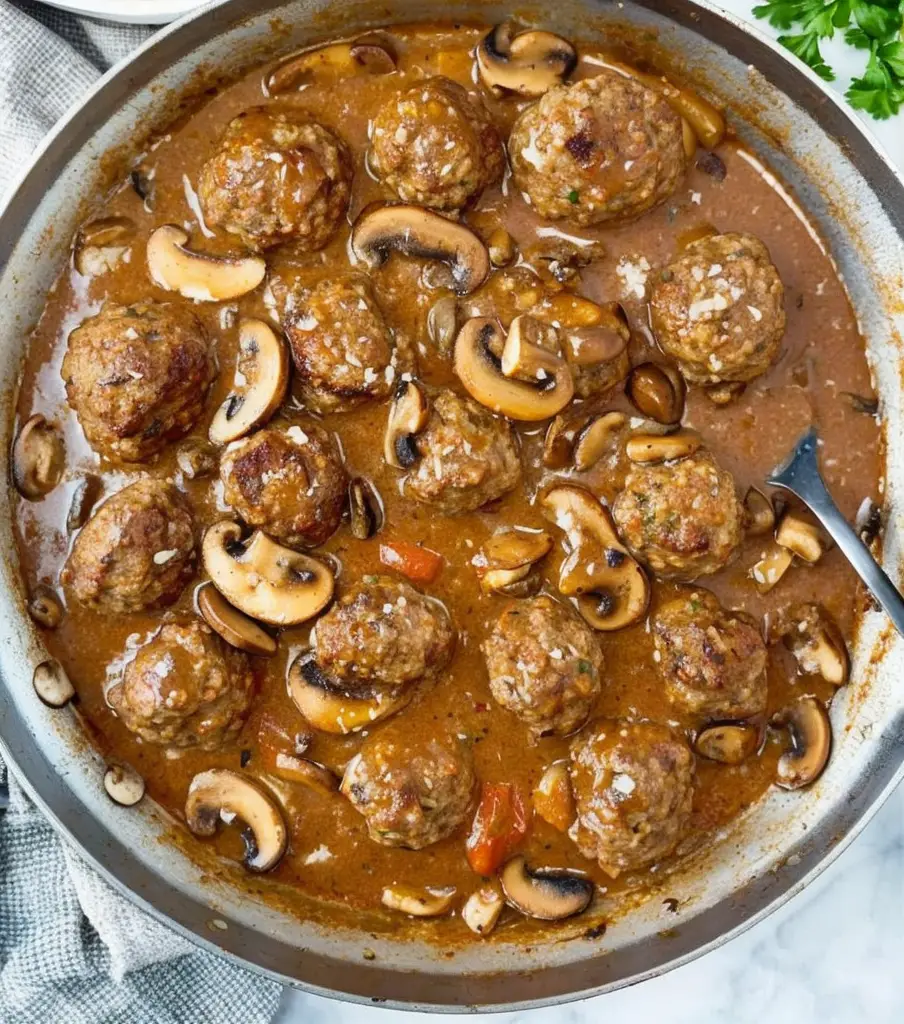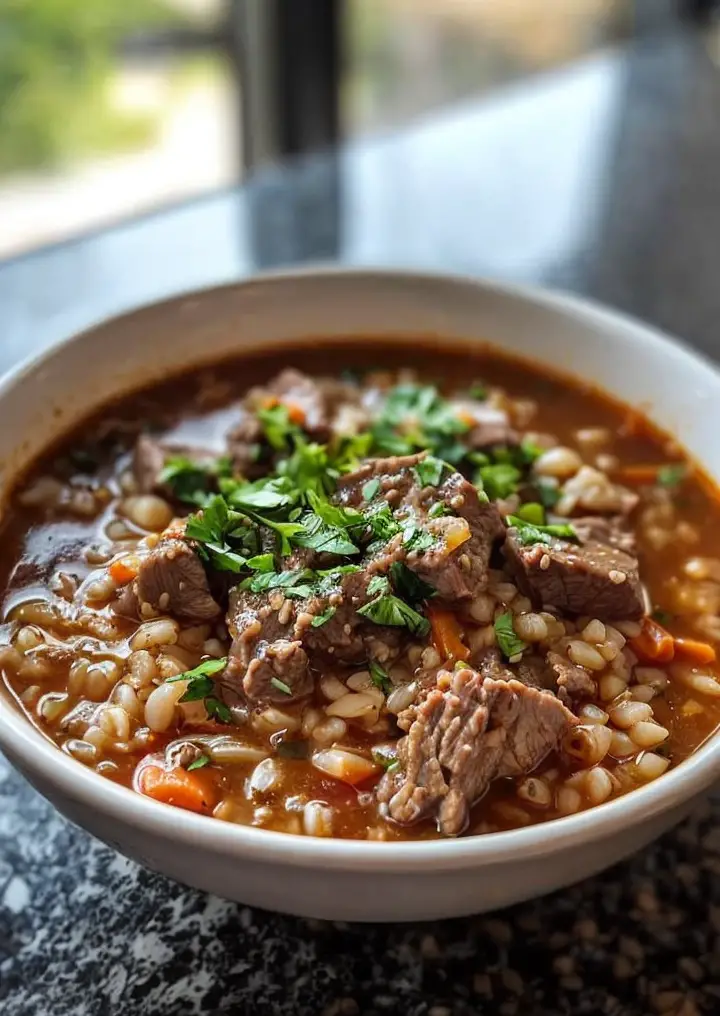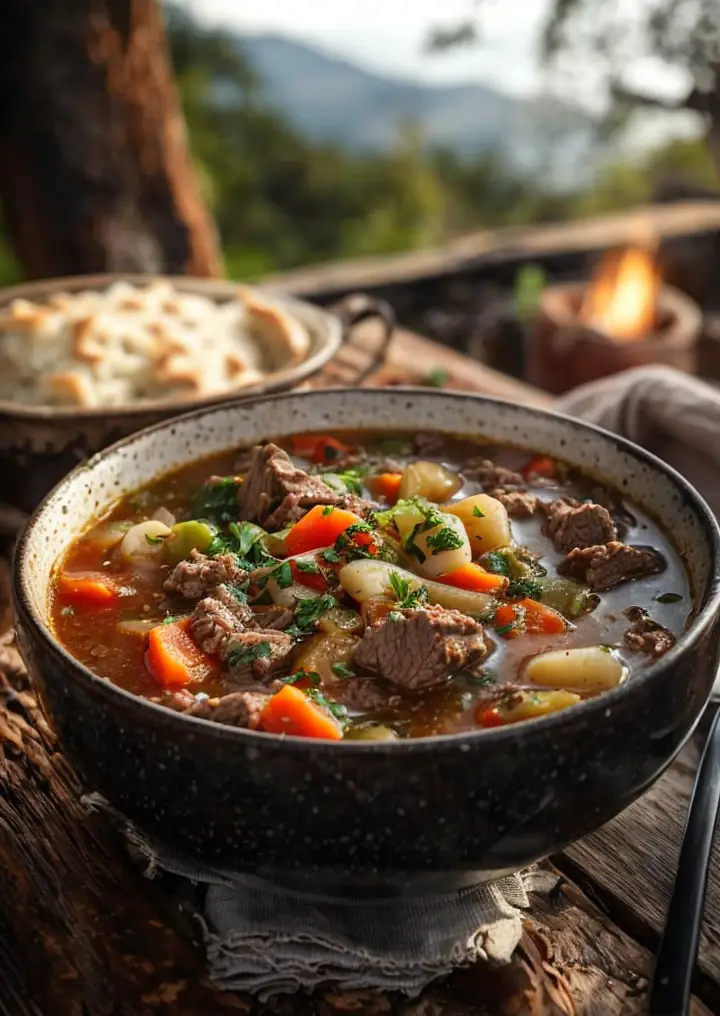Gourmet Meatballs with Rich Mushroom Gravy: A Comfort Food Classic
Indulge in the rich flavors of Gourmet Meatballs with Rich Mushroom Gravy, a dish that celebrates the comforting essence of home cooking. These meatballs are lovingly crafted from high-quality ground meat, combined with fragrant herbs and spices, and enhanced by the umami notes of freshly sautéed mushrooms. The elegance of this recipe makes it perfect for any occasion, whether it’s a family dinner or a special gathering with friends.
Each bite offers a delightful combination of textures—from the tender meatballs to the velvety gravy that envelops them, making this dish a true feast for the senses. The savory aroma wafting from your kitchen as the mushrooms simmer alongside the meatballs will have your family eagerly awaiting mealtime. Experience the joy and satisfaction of serving a classic comfort food that balances heartiness with gourmet flair.
Quick Recipe Highlights
- Flavor Profile: The gourmet meatballs deliver a savory balance of herbs, spices, and the earthy richness of mushrooms, covered in a luscious gravy that enhances each bite.
- Texture: Expect tender meatballs complemented by a smooth, creamy gravy that adds a luxurious mouthfeel.
- Aroma: The fragrant blend of sautéed mushrooms, garlic, and fresh herbs fills your kitchen with an irresistible scent.
- Visual Appeal: Serve the meatballs in a deep, rich gravy, garnished with fresh parsley for a pop of color against the warm brown tones.
- Skill Level Needed: This recipe requires intermediate cooking skills, including sautéing and sauce-making, suitable for home cooks looking to elevate their culinary abilities.
- Special Equipment: A skillet for browning the meatballs, a mixing bowl, and measuring tools are essential for success in this recipe.
Recipe Overview
- Difficulty Level: This recipe falls into an intermediate category due to the need for multitasking and the techniques involved in creating the perfect meatball and gravy.
- Category: Gourmet Meatballs with Rich Mushroom Gravy is ideal for hearty dinners and special occasions, embodying a comforting yet refined dining experience.
- Cuisine: This dish draws inspiration from traditional Italian and American cooking, marrying rich flavors with comfort elements.
- Cost: The ingredients are moderately priced, providing good value for a gourmet meal that can impress guests.
- Season: Perfect for fall and winter, this dish offers warmth and comfort during colder months, making it a family favorite.
- Occasion: Great for family gatherings, dinner parties, or as a satisfying weeknight meal when you want something special.
Why You’ll Love This Recipe
The Gourmet Meatballs with Rich Mushroom Gravy will quickly become a favorite thanks to their incredible taste and texture. The combination of premium ground meat and aromatic mushrooms creates a depth of flavor that is hard to resist. Each meatball is juicy, while the gravy contributes a luxurious richness that coats every bite, making it perfect over pasta or mashed potatoes.
Convenience is another reason to love this dish. Although it requires some prep time, the steps are straightforward, allowing you to create a restaurant-quality meal right in your home kitchen. Plus, the ingredients are generally available in most grocery stores, making it easy to gather what you need.
From a nutritional perspective, this recipe provides protein from the meatballs, while the mushrooms add fiber and essential nutrients. This balance makes it a wholesome option for those seeking to maintain a healthy diet without sacrificing flavor.
When it comes to entertaining, these gourmet meatballs shine. Their elegant presentation and delicious taste make them a fantastic choice for serving guests. Pair them with a side salad or crusty bread, and you have a complete meal that everyone will enjoy.
Lastly, consider the cost-effectiveness of this dish. With just a few high-quality ingredients, you can make a substantial meal that satisfies everyone at the table. This recipe is designed to impress without breaking the bank, allowing for an elegant dining experience at home.
Historical Background and Cultural Significance
Gourmet meatballs have a storied history that traverses various cultures, with roots in ancient Roman cuisine. Initially, meatballs were fashioned as a way to use leftover meats, making them a humble yet resourceful dish. Over time, the concept evolved, gaining prominence in traditional Italian and American households, each adding their unique spin on flavors and cooking techniques.
Culturally, meatballs represent comfort and home-cooked meals. They have been served at family gatherings and festive occasions, symbolizing togetherness and warmth. Whether in an Italian Sunday dinner or served at a holiday buffet, these tasty morsels bring people together, creating cherished memories around the table.
The evolution of the gourmet meatball reflects changing tastes and trends in cuisine. Once merely a simple meal, it has transformed into a beloved dish featured in high-end restaurants and home kitchens alike, where chefs innovate with spices, sauces, and presentation.
Regional variations of meatballs showcase local ingredients and flavors. For example, Swedish meatballs feature a creamy sauce, while Middle Eastern kofta incorporates fragrant spices and herbs, each telling a story of its cultural heritage.
Ingredient Deep Dive
Ground Beef: This versatile ingredient is central to the meatball, providing a robust flavor and satisfying texture. Rich in protein, iron, and essential nutrients, it’s a staple in many diets. When selecting ground beef, look for blends with a good fat content for moisture without excessive grease. Store it in the refrigerator for 1-2 days or freeze it for longer preservation, and consider leaner cuts if health is a priority.
Mushrooms: Known for their umami flavor, mushrooms enrich the gravy and add depth to the dish. They’re low in calories but high in nutritional value, offering fiber, vitamins, and antioxidants. Fresh mushrooms are ideal, but dried varieties can be used for intense flavor. Store fresh mushrooms in a paper bag in the fridge, and be sure to substitute with other types like shiitake or cremini for variety.
Breadcrumbs: These are often used as a binding agent in meatballs, contributing to their texture. Made from stale bread, breadcrumbs offer a crispy finish when baked. Opt for homemade or whole-grain options for better nutrition. Keep breadcrumbs in a cool, dry place, and they can last several months. If gluten sensitivity is a concern, consider almond or oat flour as alternatives.
Common Mistakes to Avoid
- Overmixing: When combining the meat mixture, don’t overdo it. Overmixing can lead to tough meatballs rather than tender, juicy ones.
- Skipping the resting time: Allowing the meatballs to rest before cooking helps them hold their shape and enhance their flavor.
- Not browning properly: Give meatballs enough time in the skillet to develop a good sear. This step is crucial as it adds depth to the final dish.
- Using the wrong meat: Opt for a blend of meats for a richer flavor. Using only lean meat may result in dry meatballs.
- Cooking at too high heat: Cooking meatballs over high heat can burn them on the outside while leaving them raw in the center.
- Thickening the gravy improperly: Avoid adding cornstarch directly to the sauce without mixing it in a separate bowl, which can lead to lumps.
- Serving immediately: Allow the meatballs to rest after cooking to let the flavors meld for a more cohesive dish.
- Ineffective storage: Store leftovers properly in airtight containers to maintain their freshness and flavor.
Essential Techniques
Browning Meatballs: This technique is crucial for developing flavor. Browning creates a crust that enhances the overall taste of your dish. To achieve perfect browning, ensure your pan is hot enough before adding the meatballs, and avoid crowding the pan to maintain high heat.
Making a Rich Gravy: Creating a flavorful gravy is an art. Start by sautéing onions and mushrooms in the renderings from the meatballs to build a flavor base. Gradually add in broth to deglaze the pan, scraping up lovely browned bits that contribute to the sauce’s complexity.
Pro Tips for Perfect Gourmet Meatballs with Rich Mushroom Gravy
1. Use a combination of meats: Mixing ground beef with ground pork can elevate flavors and improve moisture.
2. Don’t forget seasoning: Be generous with salt, pepper, and spices, as the flavor of the meat must shine through the gravy.
3. Opt for fresh, high-quality breadcrumbs: Fresh breadcrumbs have a lighter texture and better flavor than store-bought varieties.
4. Control the size: Using a scoop to form uniform meatballs ensures even cooking and consistent texture.
5. Allow time for flavors to meld: Let the meatballs simmer in the gravy for a few minutes before serving to enhance the overall flavor.
6. Modulate the gravy thickness: Adjust the consistency of the gravy to your liking by adding more broth or allowing it to reduce further on the heat.
7. Garnish creatively: Fresh herbs like parsley or chives add a beautiful touch and a burst of freshness.
8. Experiment with spices: Don’t hesitate to introduce different herbs and spices to customize your meatballs to your taste.
Variations and Adaptations
Regional Variations: Explore different flavor profiles by integrating regional spices. For instance, try adding cumin and coriander for a Middle-Eastern flair or parmesan cheese for an Italian twist.
Seasonal Adaptations: In summer, you can grill the meatballs for a smoky flavor. In winter, incorporate warming spices like cinnamon for a comforting meal.
Dietary Modifications: To make this dish gluten-free, substitute regular breadcrumbs with gluten-free options like almond flour or crushed rice cakes.
Flavor Variations: Infuse the meatball mixture with different cheeses, herbs, or citrus zest for a personal flavor touch.
Texture Modifications: For added crunch, consider incorporating finely chopped vegetables like carrots or bell peppers in the meatball mixture.
Presentation Alternatives: Serve the meatballs over roasted vegetables or zoodles for a lighter, more modern take on the dish.
Serving and Presentation Guide
Plating techniques are essential for an elegant presentation. Use a clean, white plate to contrast the colors of the dish. Lay a bed of mashed potatoes or pasta, and then artistically pile the meatballs on top, cascading the rich gravy over them.
Garnishing ideas include a sprinkle of freshly chopped parsley or a drizzle of balsamic reduction to add visual interest and flavor. Complement your servings with crusty bread or a fresh green salad for added textures and colors.
For modern serving suggestions, consider using small cast iron skillets for individual portions, bringing a rustic touch to your table. Temperature is crucial—ensure meatballs are served hot to enhance their appeal and ensure a comforting experience.
Portion control tips recommend serving two meatballs per person, depending on their size, allowing room for sides without overwhelming the plate.
Wine and Beverage Pairing
Wine pairings for Gourmet Meatballs with Rich Mushroom Gravy can enhance the dining experience. A robust red wine like Cabernet Sauvignon or a smooth Merlot complements the savory flavors beautifully. For a lighter option, consider a Pinot Noir which tends to have a fruity, acidic profile that pairs well with meat dishes.
Non-alcoholic alternatives might include sparkling grape juice or a refreshing iced tea with lemon. The acidity in these beverages works well to balance the richness of the dish.
If coffee is your preference post-dinner, choose a medium roast that highlights the earthiness of the meatballs while providing a delightful end to the meal.
Temperature considerations matter too; serve red wine slightly chilled to keep it refreshing, especially during warmer seasons.
Storage and Shelf Life
To keep your Gourmet Meatballs and Gravy fresh, store leftovers in airtight containers in the refrigerator for up to three days. Make sure they cool before sealing them to avoid condensation. If you want to preserve them longer, freezing is an option—just ensure they are well-packed in freezer-safe containers or bags.
Temperature requirements demand your meatballs be reheated to an internal temperature of 165°F before serving. Reheat gently on the stovetop or in the microwave, adding extra broth if the gravy seems thick.
Signs of spoilage include an off smell or discoloration, so always check before consuming leftovers.
For best results, freeze meatballs without the gravy to maintain their texture, adding the sauce after reheating.
Make Ahead Strategies
To streamline your cooking process, consider preparing the meatball mixture a day in advance, allowing flavors to meld. Store the uncooked mixture in the refrigerator and form meatballs just before cooking.
For step-wise storage, prepare the gravy and refrigerate it separately from the meatballs. This prevents the meat from becoming soggy.
Assess the quality impact: While you can make meatballs in advance, they are best when freshly cooked. However, cooked meatballs can last well in the fridge and remain delicious next day.
Timing during prep can be crucial; prepare the meatball mix while the gravy is simmering to optimize kitchen time.
Reheating guidelines suggest gentle warming over low heat with a splash of broth to keep them moist.
Don’t forget to add any fresh herbs just before serving to brighten the dish after reheating.
Scaling Instructions
Halving the recipe is straightforward—just divide all ingredients by two—ideal for smaller households. Keep in mind the cooking time may slightly decrease.
For doubling or tripling, ensure you have adequate cooking space; larger batches may require cooking in batches for optimal results. Adjust the timing slightly, as larger quantities may take longer to heat through.
When scaling up, consider using larger pots or skillets to accommodate the expanded volume, ensuring even cooking.
Don’t forget about storage considerations: left over meatballs can be stored for future meals, keeping portion sizes manageable.
Nutritional Deep Dive
In terms of macronutrients, these meatballs provide significant protein, essential for muscle repair and growth. The combination of meat and mushrooms contributes valuable fiber, aiding digestion, and enhancing satiety.
Micronutrient analysis reveals the richness of iron in the beef paired with vitamin D and B vitamins often found in mushrooms, making this a nutritionally robust dish.
Health benefits abound as this meal is packed with iron and protein while being lower in carbohydrates, depending on the serving choice of sides.
Dietary considerations also come into play; adjust portions for overall caloric intake and consider accompanying sides that align with personal nutrition goals.
Weight management tips advise pairing meatballs with vegetables or whole grains to enhance fullness while enjoying this gourmet dish.
Dietary Adaptations
For gluten-free adaptations, use certified gluten-free breadcrumbs or explore alternatives like quinoa or almond flour for binding.
If you need a dairy-free version, omit any cheese and use non-dairy options for the gravy. Coconut milk is a great alternative that offers creaminess without the dairy.
For a vegan take, replace meat with lentils or mushrooms, and use flaxseed meal as a binder in place of eggs, ensuring the same comforting flavor profile.
Adjustments can also be made to fit low-carb or keto diets, swapping breadcrumbs with crushed pork rinds or almond exteriors to keep the meatballs satisfying without the carbs.
Paleo followers can utilize ground turkey or chicken, for a lighter meat while adhering to paleo-friendly ingredients.
Troubleshooting Guide
Texture issues often arise if meatballs are overmixed. Ensure you mix just until combined to prevent dense meatballs. If they fall apart while cooking, consider adding an egg to the mixture for better binding.
Flavor balance can be challenging; always taste and adjust seasoning. If the meatballs turn out bland, a double check on salt before serving can go a long way.
Temperature problems may occur if your meatballs are not fully cooked. Invest in a meat thermometer to ensure they reach an internal temperature of 165°F.
Equipment challenges might include the need for larger skillets when cooking in batches. Have more than one cooking surface ready, or cook smaller batches to avoid overcrowding.
Ingredient substitutions need to be planned ahead—if you need to swap out an ingredient last minute, ensure you have an alternative that complements the dish’s flavor profile.
Timing concerns can be addressed by prepping components ahead of time. If you’re short on time, consider making the meatballs in advance or using frozen meatballs for an even quicker option.
Recipe Success Stories
Community feedback often highlights how gourmet meatballs bring families together over a comforting plate of food. Many have noted adjustments they made, from tweaking seasoning to leveraging local ingredients for unique variations.
Variation successes speak to the flexibility of the recipe; some users have successfully incorporated vegetarian alternatives, creating delightful lentil-based meatballs that still satisfy.
Adaptation stories showcase creative takes on this classic, with readers sharing how they innovated the dish to fit dietary needs while maintaining its essence.
Photography tips reveal that presenting the dish with a sprinkle of vibrant herbs not only enhances visual appeal but makes a dish memorable, urging others to recreate these gourmet meatballs in their kitchens.
Frequently Asked Questions
Can I freeze the meatballs and gravy?
Yes, you can freeze the meatballs separately from the gravy for optimal texture. Store in airtight containers, ensuring they are cooled completely before freezing. Thaw in the fridge overnight and reheat before serving.
What can I serve with gourmet meatballs?
Gourmet meatballs pair beautifully with sides like mashed potatoes, pasta, or a fresh green salad. Crusty bread is also a fantastic option for soaking up the delicious gravy!
Can I make this dish ahead of time?
Absolutely! You can prepare meatballs and the gravy a day ahead. Just reheat gently before serving for best results.
What type of ground meat works best?
A mix of ground beef and pork often yields the best flavor and moisture. However, feel free to experiment with turkey or chicken for leaner options.
Can I make this recipe dairy-free?
Yes, simply skip any dairy ingredients in the gravy. Coconut milk can be a delicious alternative that provides creaminess without dairy.
How do I prevent meatballs from falling apart?
To help meatballs hold their shape, do not overmix your ingredients, and ensure you are using the right amount of breadcrumbs or fillers. Adding an egg can also provide extra binding.
What spices are essential for flavor?
Essentials include salt, black pepper, garlic powder, and Italian seasoning. Fresh herbs like parsley or basil can enhance flavor greatly.
Can I use dried mushrooms in the gravy?
Absolutely! Dried mushrooms can add an intense flavor to the gravy. Be sure to rehydrate them in warm water before adding to your sauce.
How many servings does this recipe make?
This recipe serves about four people, depending on portion sizes and side dishes served. It can be easily scaled up or down.
What kitchen tools do I need?
You will need a mixing bowl, a skillet for browning the meatballs, and a pot for making the gravy. A meat thermometer can also be useful for ensuring proper cooking temperature.
Additional Resources
Explore related recipes for more comfort food ideas, including classic spaghetti and meatballs or creamy mushroom risotto. Discover technique guides for mastering meatball-making and browse ingredient information for substitutions and tips on freshness.
Look for equipment recommendations focused on essential kitchen tools that can enhance your cooking experience, and don’t miss out on seasonal variations that highlight fresh produce throughout the year.
Join the Conversation
We’d love to hear about your experiences with this Gourmet Meatballs with Rich Mushroom Gravy recipe! Share your photographs, provide feedback, and engage with the community through social media. Together, we can inspire more culinary adventures and discover delicious variations.
The Recipe
Gourmet Meatballs with Rich Mushroom Gravy
Serves: 4
Prep Time: 20 mins
Cook Time: 30 mins
Total Time: 50 mins
Kitchen Equipment Needed
- Mixing bowl
- Skillet
- Measuring tools
- Spatula
- Meat thermometer
Ingredients
- 1 lb ground beef
- 1/2 lb ground pork
- 1/2 cup breadcrumbs
- 1/4 cup milk
- 1 egg
- 2 cloves garlic, minced
- 1 tsp salt
- 1/2 tsp black pepper
- 1 tsp Italian seasoning
- 8 oz mushrooms, sliced
- 1 onion, chopped
- 2 cups beef broth
- 2 tbsp olive oil
- Fresh parsley for garnish
Directions
- In a mixing bowl, combine ground beef, ground pork, breadcrumbs, milk, egg, garlic, salt, pepper, and Italian seasoning. Mix until just combined.
- Form the mixture into approximately 1-inch meatballs.
- Heat olive oil in a skillet over medium heat. Add meatballs and brown on all sides. Remove from skillet and set aside.
- In the same skillet, add onions and mushrooms. Sauté until softened. Pour in beef broth, scraping the bottom of the pan for flavor.
- Return the meatballs to the skillet, cover, and let simmer for 15-20 minutes.
- Adjust seasoning if needed, and garnish with fresh parsley before serving.
Recipe Notes
- For extra flavor, add grated parmesan cheese to the meat mixture.
- Feel free to substitute any ground meat for the beef and pork.
- This dish pairs well with spaghetti or mashed potatoes.




